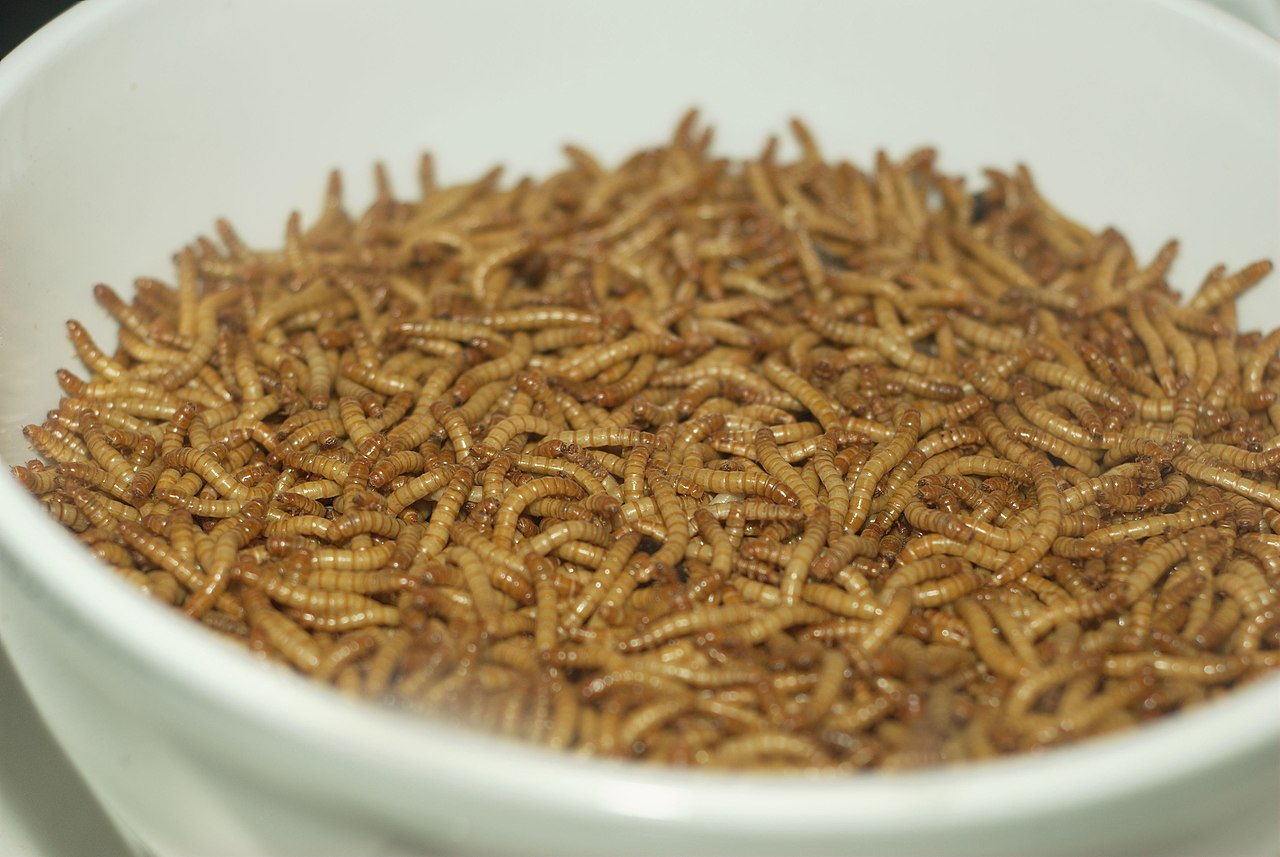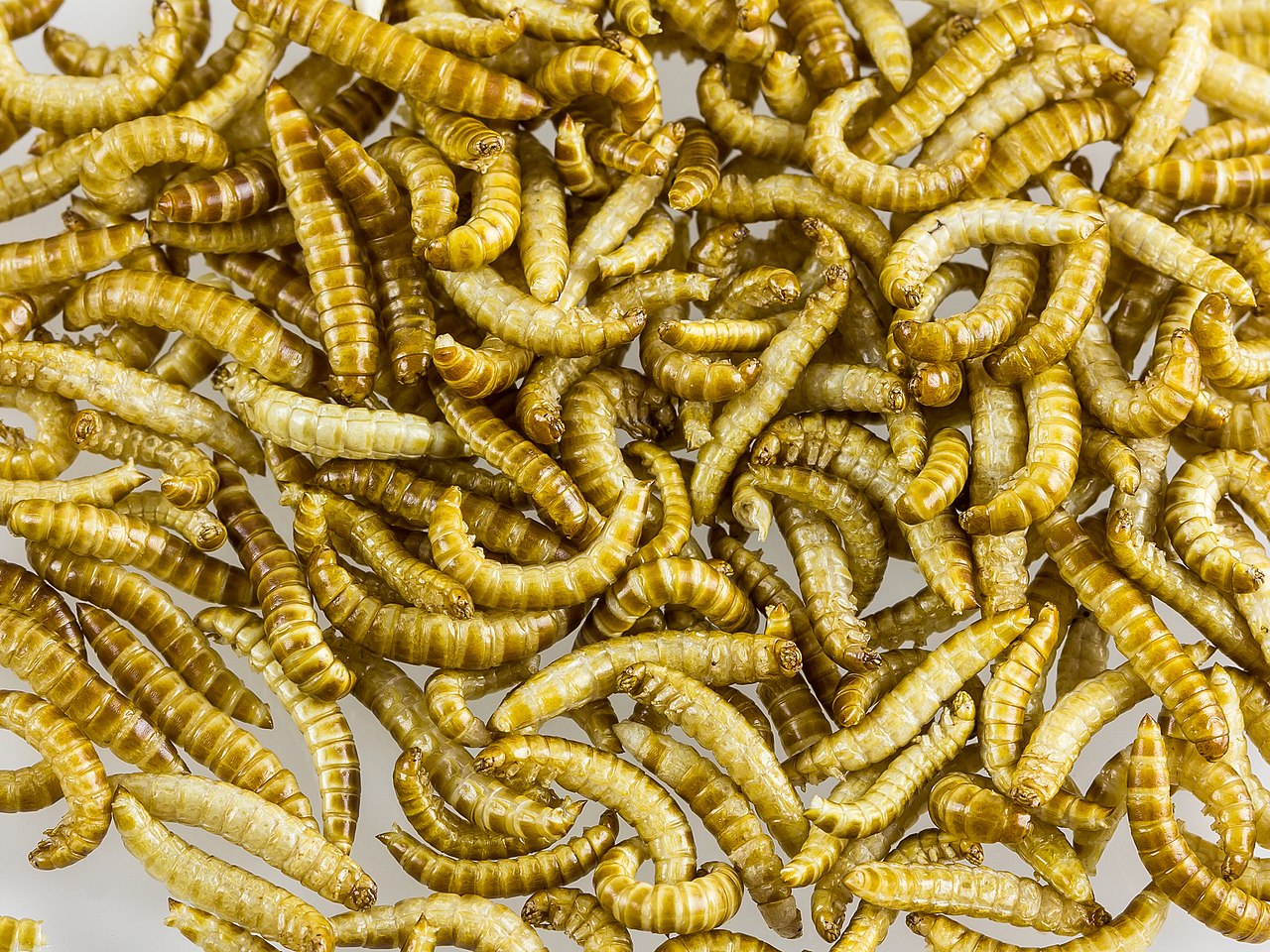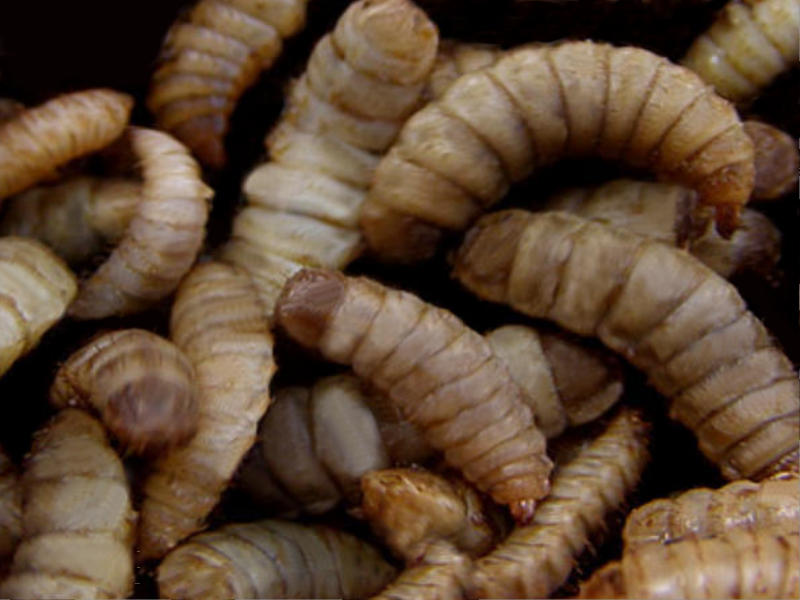Chameleons that live in captivity will eat what you feed them. Insects are a popular choice with chameleon owners with crickets (and dubia roaches) being their staple food.
Feeding only crickets isn’t enough to provide them with their daily nutritional requirements, which means feeding other foods.
One of the feeder foods you may want to feed is mealworms and you may be wondering how safe they are.
Continue reading to find out more.
What Are Mealworms?
What you may not realize is that mealworms are not worms at all, but they are the larvae of the flour beetle. It is a non-invasive species and can be found just about anywhere in the world.

Mealworms prefer dark and high-density areas with high humidity.
Mealworms comprise of: (source)
- 64% moisture
- 17.6% protein
- 13.8% lipid
- 3.1% carbohydrates
- 1.5% ash
Pros Of Mealworms
There are many advantages to feeding mealworms to your chameleon, which includes:
Omega 3 Fatty Acids
Mealworms are rich in Omega 3 fatty acids which help with bone and joint health while keeping skin and eyes healthy.
Vitamin B
Vitamin B is essential in breaking down fats and proteins in chameleons, it helps them with metabolism and energy production while keeping skin, muscles, and healthy eyes.
Mealworms have vitamins B5 and B12, both of which are important for the growth and development of your chameleon pet.
Proteins
The proteins found in mealworms can help your chameleon repair muscles, regulate their blood, and keep their skin healthy.
Fiber
Mealworms are rich in fiber, which helps with digestion and reduces the risk of constipation in chameleons.
Easy Storage
Mealworms can be kept in the refrigeration after bringing them home for up to two weeks, which means that they don’t have to be fed right away, but can be offered as treats to your chameleon pet.
High in Moisture
The high moisture content of the mealworm makes it the perfect food or treat for a dehydrated chameleon.
Cons Of Mealworms
Even with so many benefits of feeding mealworms to your chameleon, you also need to know the cons associated with these feeder worms, which includes:
Increased Risk of Impaction
One of the biggest concerns among chameleon owners regarding feeding mealworms to their pets is that they are hard to digest and could cause impaction.
Impaction is a very serious form of constipation that often requester veterinary assistance to remove the blockage.
Addictive
Another of the downsides of mealworms is that they are addictive to reptilian pets, including chameleons.
This is why chameleon owners recommend only feeding mealworms as a treat and only offering them after your pet has eaten its crickets.
Chameleons that eat mealworms regularly often refuse to eat anything else.
Risk of Parasites
Mealworms can carry parasites and mites, which can be transferred to your pet.
Keep a close eye on your pet and their habitat for signs of parasites when feeding mealworms on a regular basis.
Can Cause Reaction in Humans
Mealworms contaminate everything they touch, including your hands when you feed them to your pet.
It is important to wash your hands thoroughly after handling mealworms to reduce the risk of touching your mouth or face.
If you accidentally ingest a mealworm or part thereof, you can expect abdominal discomfort.
High Moisture Content
While the high moisture content is beneficial to a dehydrated chameleon, it can cause diarrhea in a healthy pet, which is why you only want to feed mealworms as a treat now and then.
Can Chameleons Eat Mealworms
Considering from above pros and cons, mealworms are not recommended as a regular good for your chameleon, but rather as an occasional treat.
They are hard to digest and therefore increase the risk of impaction, which will require veterinary treatment. Therefore, it is also recommended that mealworms are left for more experienced chameleon owners
How About Dried Mealworms?
You can feed your chameleon dried mealworms, but only as an emergency and if you don’t have live food on hand.
The dried worms don’t contain the high protein that the live mealworms have. Even though the mealworms are dried, they can contain pathogens and parasites, which can result in your pet becoming sick.
Remember that chameleons are excellent when it comes to hiding illness, so most owners may not notice a problem until it is too late.
This is why dried mealworms should only be offered as a desperate measure if you have nothing else to feed your pet right now.
What Are Good Alternatives?
There are some great alternatives to mealworms, which you may want to consider, which includes:
Waxworms

Waxworms are the larvae of wax moths, which are medium-sized caterpillars.
In the wild, they are parasites to bee colonies eating pollen, bee skin, and beeswax.
When kept at reptile food they can live for long periods without eating, as long as they are kept at a cool temperature and can be fed cereal and grains, along with bran and honey.
They have a high-fat content, which is why they are recommended as a treat for your chameleon rather than a staple food. They can lead to obesity in captive chameleons.
When kept in captivity, they can go a long time without eating, particularly if kept at a cool temperature.
Captive waxworms are generally raised on a mixture of cereal grain, bran, and honey.
Buffalo Worms

Buffalo worms are larvae of small beetles growing to around 1cm in length and suitable for food for smaller chameleons, other reptiles, and even birds.
They have a thinner exoskeleton than the mealworm, making them easier to eat and digest, reducing the risk of impaction.
They are more active and faster than mealworms and will hide away, therefore even if feeding as a treat, place them in a dish.
They are high in protein, low in fat, and carbohydrates with essential vitamins and minerals.
Superworms

Superworms are also sometimes referred to as Morio worms, the larvae of the darkling beetle, resembling mealworms, but significantly larger in size, growing up to 5cm.
They are popular with reptile owners, providing the benefits of mealworms with excellent moisture content and good nutrition with a relatively hard exoskeleton.
They can be cut to size if they are too big for your chameleon, fed as a treat.
Further Reading:
Calci Worms

Calci worms are the larvae of Black Soldier Flies and store calcium in their exoskeleton, which gives them a very high calcium content, which is beneficial when feeding your chameleon.
The flies can also be fed to chameleons, making an excellent treat or food choice.
You don’t need to gut load or dust these worms before feeding.
They can be used as a supplemental insect which is high in vitamins and minerals.
Conclusion
There are a number of other feeder worms you can provide your pet as a treat, giving them the vitamins and minerals that they need, such as the Buffalo worm, which has a thinner exoskeleton and a reduced risk of impaction.
Remember with any feeder, except the Calci worm, to gut load and dust with calcium supplement to reduce the risk of metabolic bone disease.
Further Reading: